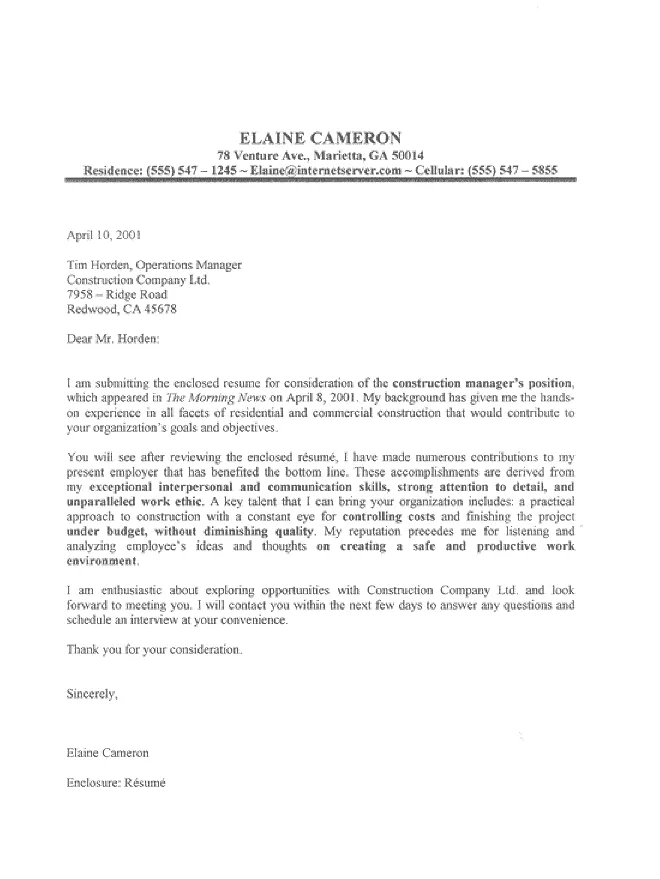What is a Construction Cover Letter
A construction cover letter is a crucial document that accompanies your resume when applying for construction-related jobs. It serves as your introduction to a potential employer, providing an opportunity to highlight your skills, experience, and passion for the construction industry. Unlike a resume that lists your qualifications, the cover letter allows you to personalize your application, explain why you’re a good fit for the specific role and company, and showcase your communication skills. It is your first impression, and a well-written cover letter can significantly increase your chances of getting an interview. It should demonstrate your understanding of the role, the company, and the construction field in general.
Why is a Construction Cover Letter Important
In a competitive job market, a construction cover letter is essential because it sets you apart from other applicants. It allows you to expand on the information presented in your resume, offering a narrative that connects your skills and experiences to the requirements of the job. Moreover, a cover letter demonstrates your communication skills, attention to detail, and genuine interest in the position and the company. Employers often use cover letters to gauge your writing ability and assess whether you have taken the time to understand their needs. A well-crafted letter can highlight your achievements, articulate your career goals, and leave a lasting positive impression, increasing your chances of landing an interview and ultimately, the job.
Key Components of a Construction Cover Letter
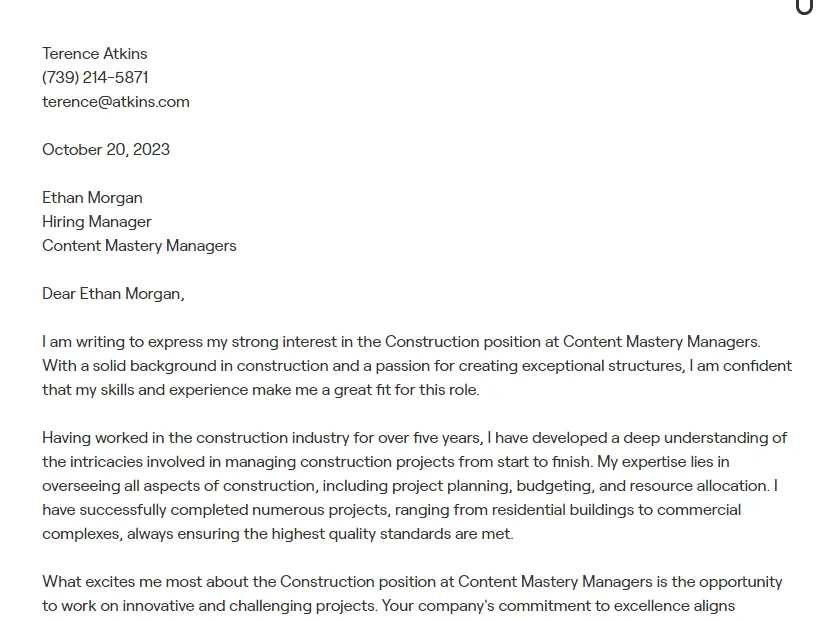
A compelling construction cover letter comprises several key components that work together to create a persuasive application. Each section serves a specific purpose in conveying your qualifications, enthusiasm, and suitability for the role. From the contact information to the closing, every element of the letter contributes to the overall impact and effectiveness of your application. It is important to have a clear and concise letter that highlights your most relevant skills and experiences for the particular job you’re applying for.
Your Contact Information
At the top of your cover letter, provide your full name, address, phone number, and professional email address. This ensures that the hiring manager can easily reach you. Ensure that your email address is professional and appropriate. This section is crucial for allowing the employer to contact you for an interview, so double-check all details for accuracy.
Date and Recipient Information
Include the date of the letter, followed by the hiring manager’s name and title, the company name, and the company’s address. If you don’t know the hiring manager’s name, research the company website or LinkedIn to find it. Addressing the letter to a specific person shows that you’ve taken the time to research the company and demonstrates your attention to detail. This personalized approach can make a positive first impression.
Opening Statement
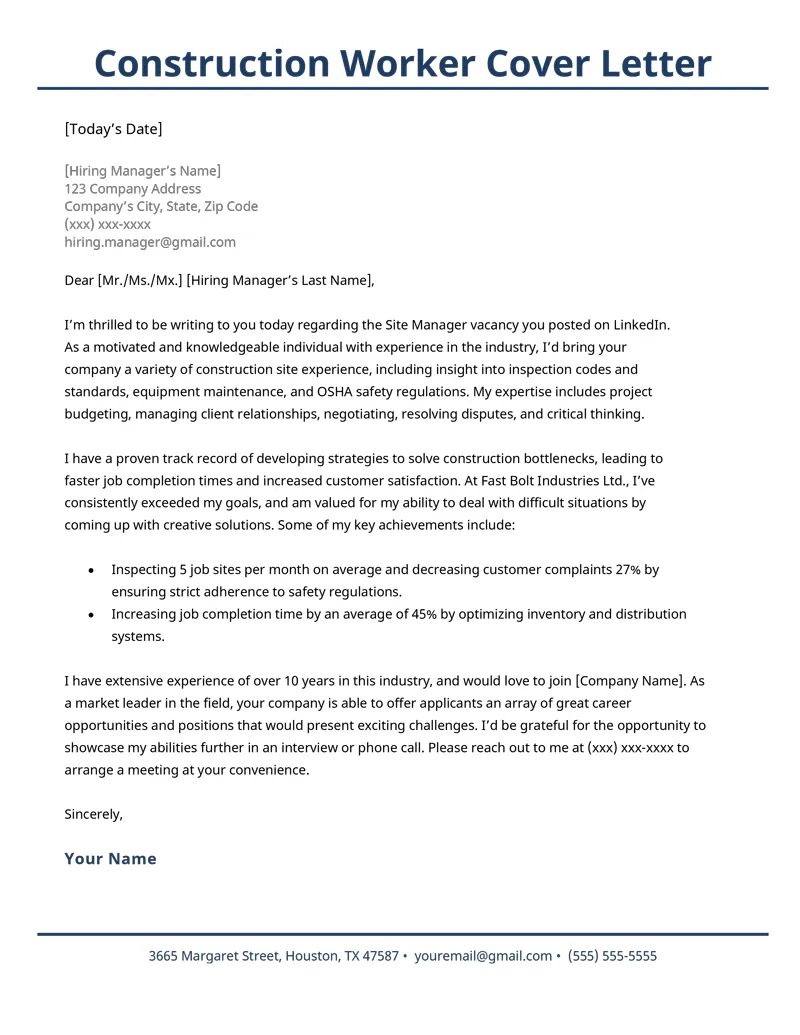
Your opening statement should immediately grab the reader’s attention. State the position you are applying for and how you learned about it (e.g., job board, company website). Express your enthusiasm for the role and the company. A strong opening sets the tone for the rest of the letter and encourages the hiring manager to continue reading. Show your interest in the specific job and how your skills align with the company’s needs.
Highlighting Skills and Experience
This is where you showcase your skills and experience relevant to the job. Focus on the key requirements outlined in the job description and provide specific examples to demonstrate how you’ve successfully used those skills in the past. Use action verbs to describe your accomplishments, such as ‘managed,’ ‘supervised,’ ‘coordinated,’ or ‘implemented.’ This section should clearly show how your qualifications make you a strong candidate for the position. Align your skills with the company’s needs.
Quantifying Achievements
Whenever possible, quantify your achievements with numbers and data. For example, instead of saying ‘managed construction projects,’ say ‘managed construction projects valued at over $5 million, completing them on time and within budget.’ Quantifiable achievements demonstrate the impact of your work and provide concrete evidence of your abilities. Use metrics to demonstrate how you have improved project efficiency, reduced costs, or increased productivity in previous roles.
Demonstrating Knowledge of the Company
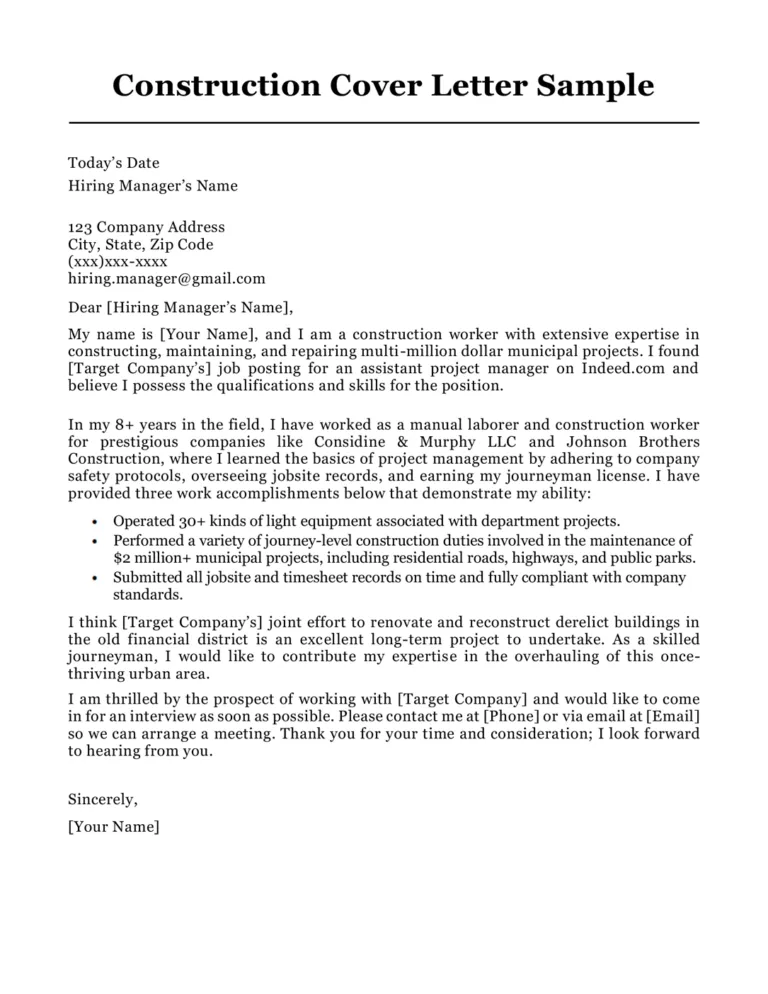
Show that you’ve researched the company by mentioning specific projects, values, or goals that resonate with you. This demonstrates your genuine interest and commitment. Referencing the company’s recent work, awards, or initiatives shows that you understand their position in the market. Tailor your letter to the specific company and role to stand out.
Expressing Enthusiasm and Interest
Convey your enthusiasm for the role and the company. Explain why you’re excited about the opportunity and what you hope to achieve. A genuine expression of interest helps you connect with the hiring manager on a personal level. Show your excitement about the specific role and what you look forward to accomplishing.
Call to Action
Conclude your letter with a clear call to action. State your availability for an interview and express your eagerness to discuss your qualifications further. Thank the hiring manager for their time and consideration. Make it easy for them to take the next step by providing a clear and concise call to action.
Closing and Signature
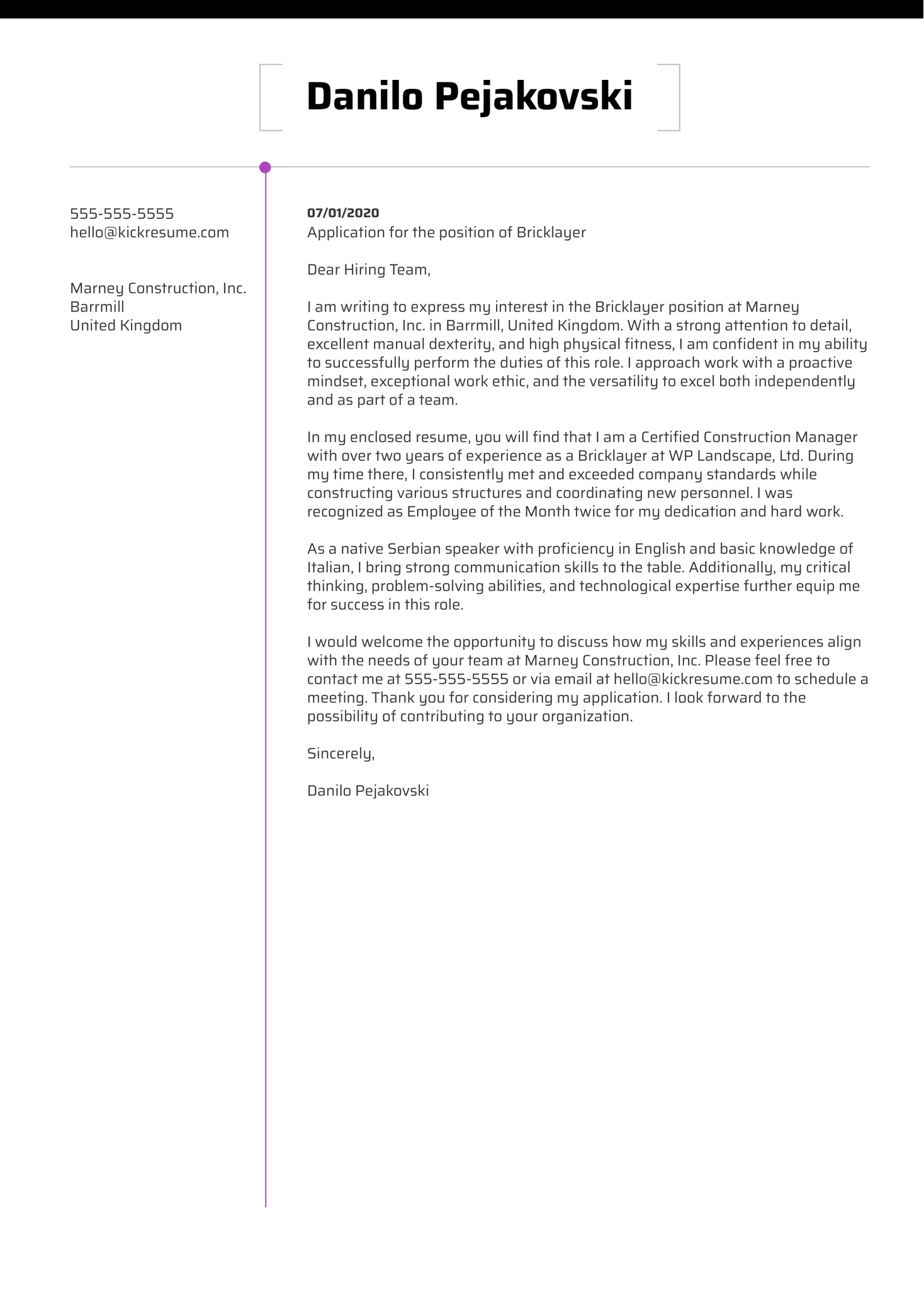
Use a professional closing, such as ‘Sincerely’ or ‘Best regards,’ followed by your typed name. If submitting a hard copy, leave space for your handwritten signature above your typed name. Ensure your closing is appropriate for the level of formality required by the company culture. Double-check that your contact information is accurate and easy to find.
Construction Cover Letter Examples
Here are some examples of cover letters for various construction roles. These examples are tailored to different job functions to give you a better idea of how to craft your own cover letter. Adapt these examples to fit your specific skills and experience. Always customize your cover letter to match the job description and company values.
Example 1 General Construction
Dear [Hiring Manager Name],
I am writing to express my keen interest in the General Construction position at [Company Name], as advertised on [Platform]. With five years of experience in various construction projects, I am confident in my ability to contribute significantly to your team. In my previous role at [Previous Company], I successfully managed multiple projects, including residential and commercial builds, ensuring timely completion and adherence to budget constraints. I am proficient in reading blueprints, coordinating with subcontractors, and overseeing all aspects of construction from foundation to finish. I am eager to bring my skills and dedication to [Company Name].
Sincerely, [Your Name]
Example 2 Project Manager

Dear [Hiring Manager Name],
I am writing to apply for the Project Manager position at [Company Name]. I have a strong background in construction management with a proven track record of successfully delivering projects on time and within budget. During my tenure at [Previous Company], I managed projects valued at over $10 million. My responsibilities included overseeing all phases of construction, from initial planning to final inspections, as well as managing teams of up to 50 construction workers. I am proficient in project scheduling, budget management, and risk mitigation. I am excited about the opportunity to contribute my expertise to [Company Name]’s innovative projects.
Sincerely, [Your Name]
Example 3 Construction Foreman
Dear [Hiring Manager Name],
I am writing to express my interest in the Construction Foreman position at [Company Name]. With a strong background in construction supervision and a commitment to safety, I am confident I can lead your team to success. I have extensive experience coordinating construction activities, ensuring projects are completed efficiently and safely. In my previous role at [Previous Company], I supervised a team of construction workers, managed daily operations, and ensured compliance with all safety regulations. I have experience with multiple types of construction projects, including commercial buildings and residential homes. I am dedicated to maintaining high standards and a positive work environment at [Company Name].
Sincerely, [Your Name]
Formatting and Style Guide
Proper formatting and style are critical for presenting your cover letter professionally. A well-formatted letter is easy to read and reflects your attention to detail. Adhering to these guidelines helps to create a positive impression on the hiring manager. Ensure your formatting is consistent throughout the entire document.
Font and Formatting
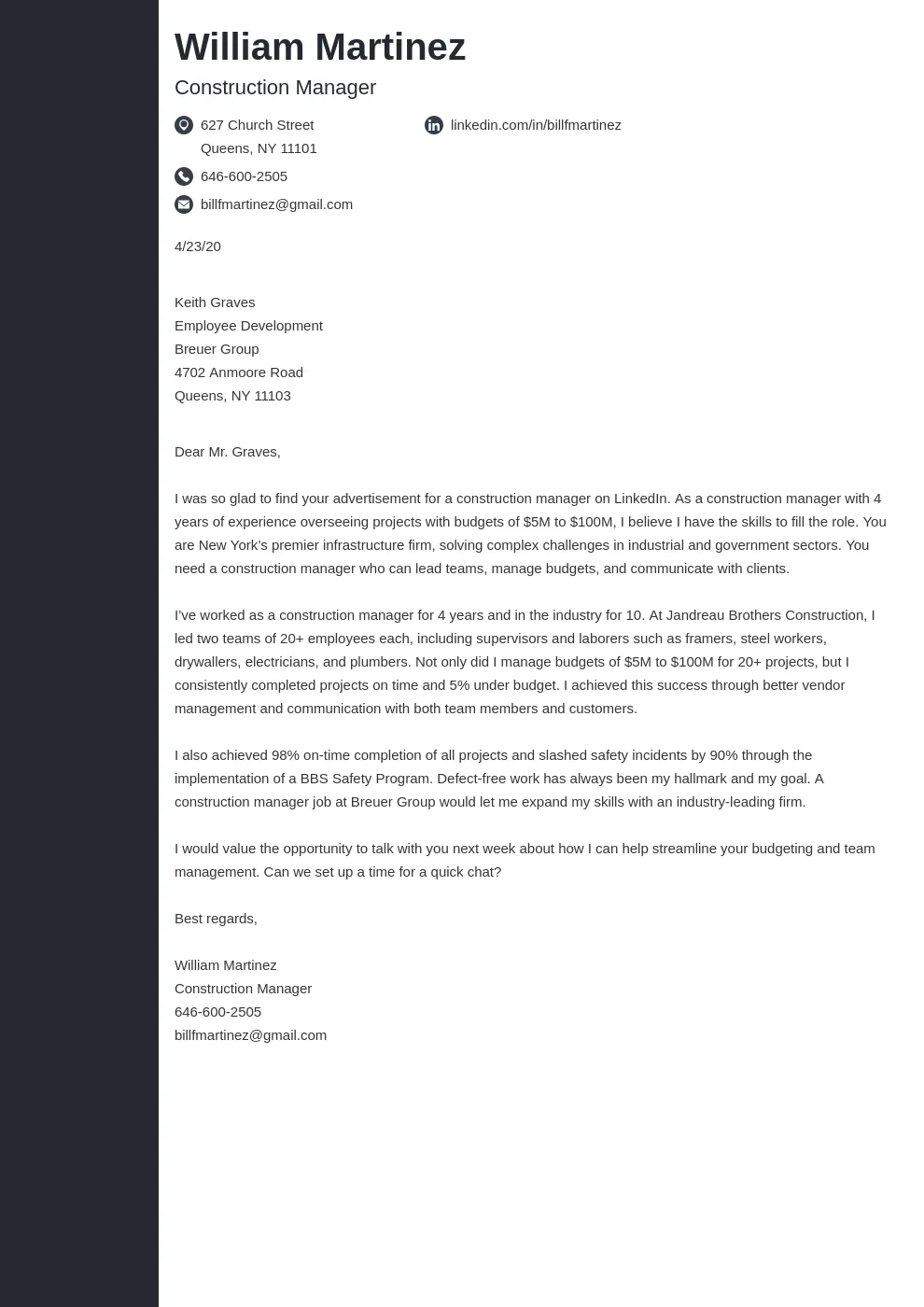
Choose a standard, easy-to-read font, such as Times New Roman, Arial, or Calibri, in a size between 10 and 12 points. Use single spacing within paragraphs and double spacing between paragraphs. Maintain consistent margins (typically one inch on all sides) and align your text to the left. Avoid excessive use of bolding, italics, or underlining, and make sure your formatting is consistent throughout the letter.
Length of the Letter
Keep your cover letter concise and to the point. Aim for a maximum of one page, typically divided into three to five paragraphs. Focus on the most relevant skills and experiences, and avoid including unnecessary details. Brevity is key, so make every word count. Ensure you present your most important qualifications early on to capture the reader’s attention.
Proofreading and Editing
Thoroughly proofread your cover letter for any grammatical errors, spelling mistakes, and typos. Ask a friend or family member to review your letter as well. Errors can undermine your credibility and create a negative impression. Always check for clarity and conciseness, ensuring the letter conveys your message effectively. Pay close attention to the company name and the job title, double-checking for accuracy to demonstrate your attention to detail.
Tips for Tailoring Your Cover Letter
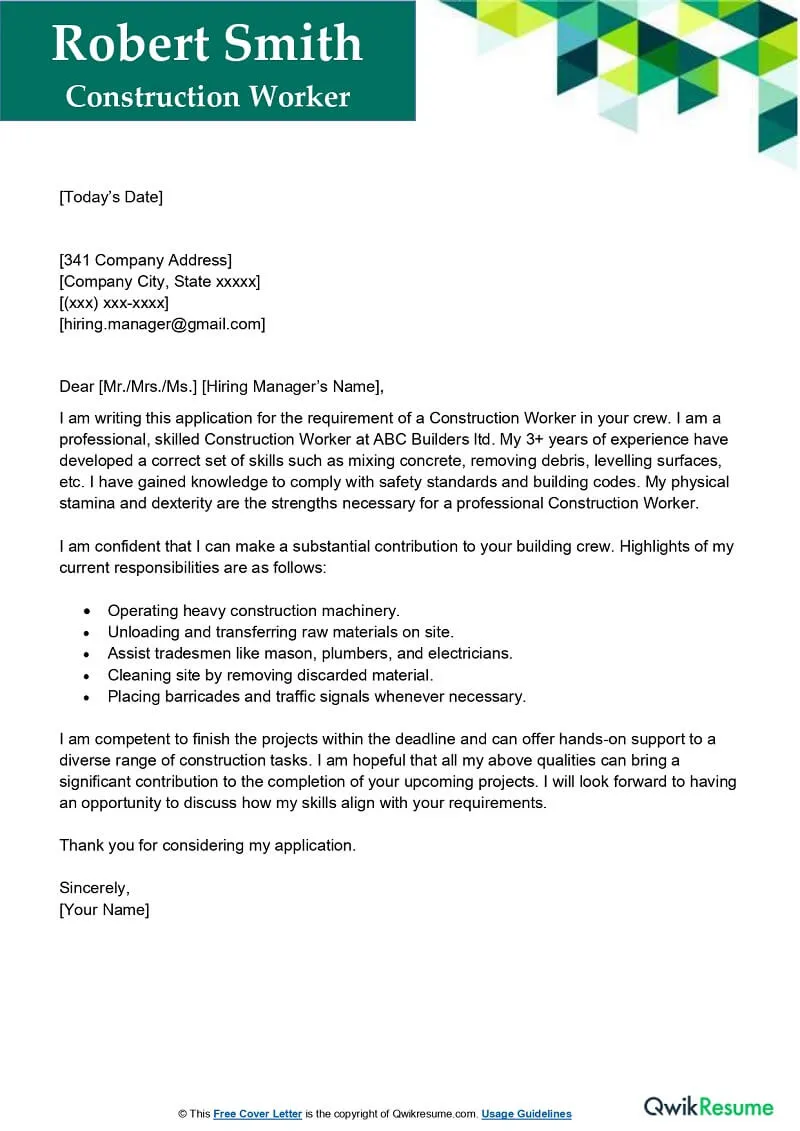
Customizing your cover letter to each specific job application is crucial for increasing your chances of success. Tailoring the letter demonstrates your genuine interest in the role and the company, and it allows you to highlight the most relevant skills and experiences. This attention to detail shows that you have invested time and effort in the application process, making you a more appealing candidate. Every application should be unique, so the hiring manager knows you want this job.
Researching the Company
Before writing your cover letter, research the company thoroughly. Visit their website, read about their mission, values, and recent projects. Understand their company culture and tailor your language to match their tone. Identify the specific needs of the company and the role you’re applying for. Mentioning specific company initiatives and projects will demonstrate your enthusiasm and interest in their work.
Matching Skills to the Job Description
Carefully review the job description and identify the key skills and qualifications the employer is seeking. Highlight your skills and experiences that align with these requirements. Use keywords from the job description to demonstrate that you meet the criteria. Provide specific examples of how you have successfully applied these skills in the past. Make sure you directly address the requirements.
Showcasing Soft Skills
While technical skills are important in construction, don’t forget to highlight your soft skills, such as communication, teamwork, problem-solving, and leadership abilities. Provide examples of how you’ve used these skills in your previous roles. Soft skills are essential for collaborating effectively with teams and resolving conflicts, making you a valuable asset. Include examples of how you have demonstrated these skills in your work.
Common Mistakes to Avoid
Avoiding common mistakes can significantly improve the effectiveness of your construction cover letter. These mistakes can undermine your application and reduce your chances of getting an interview. Pay attention to details, proofread carefully, and ensure your cover letter is polished and professional. Always tailor your cover letter for each specific job application to improve your chances.
